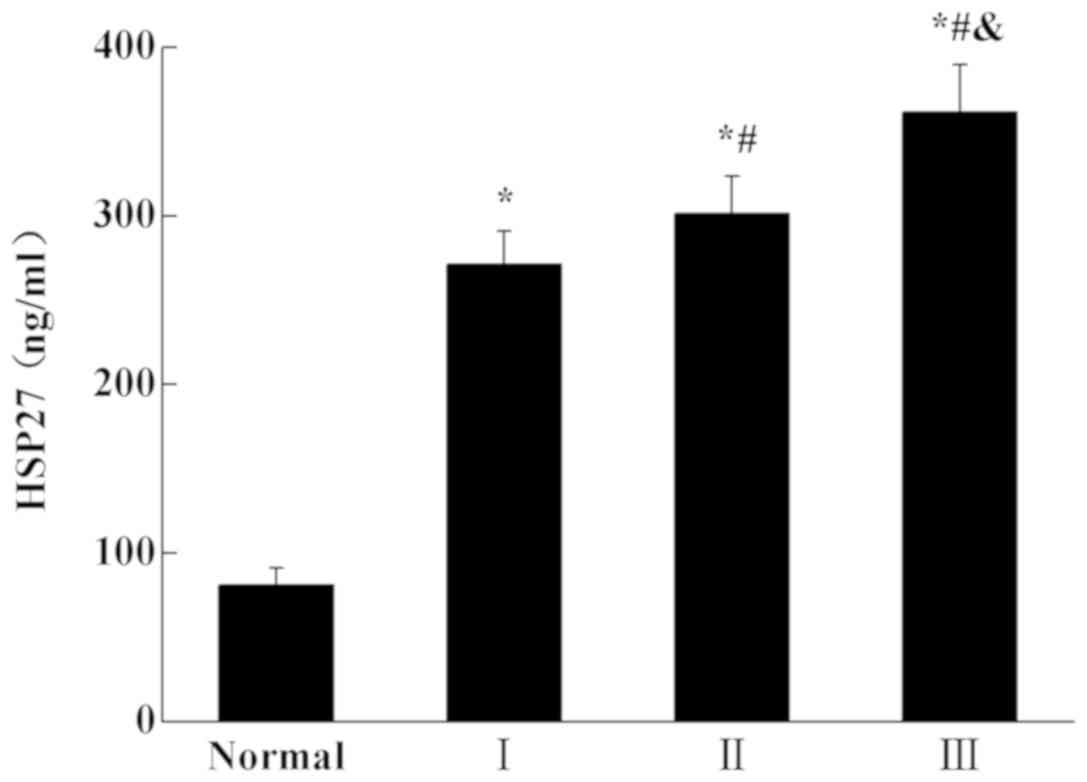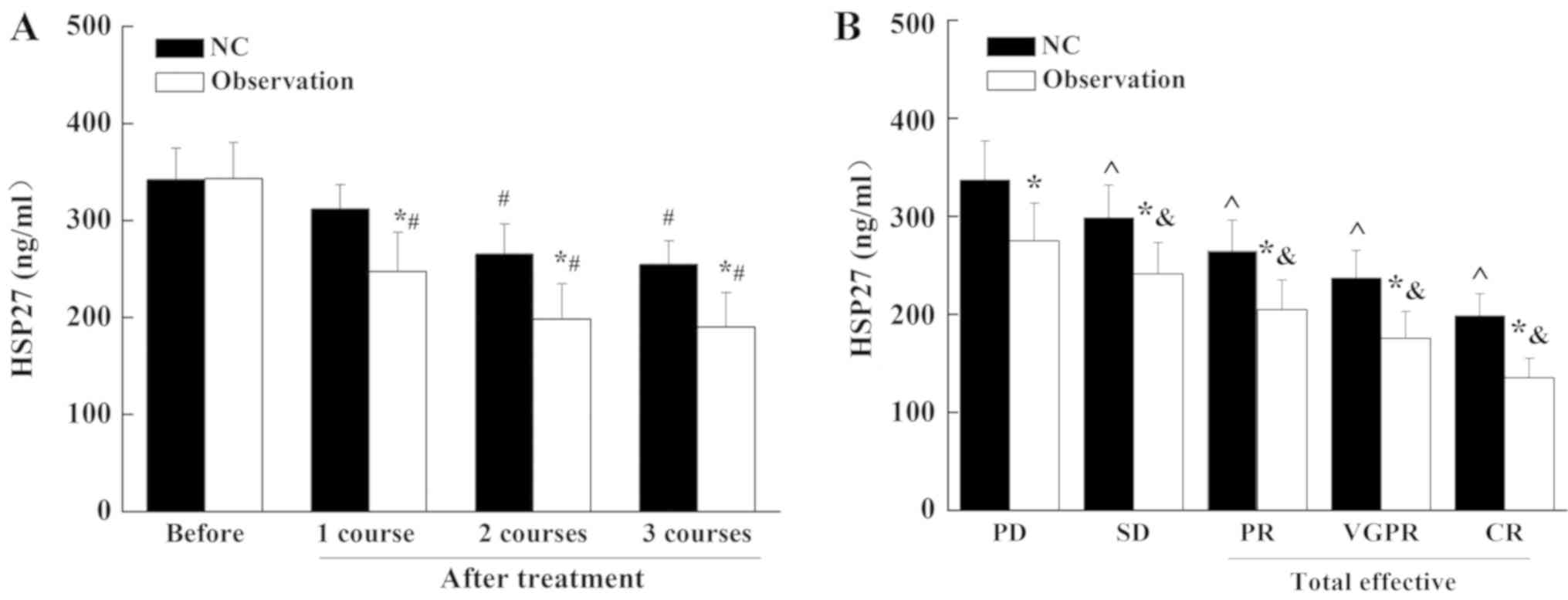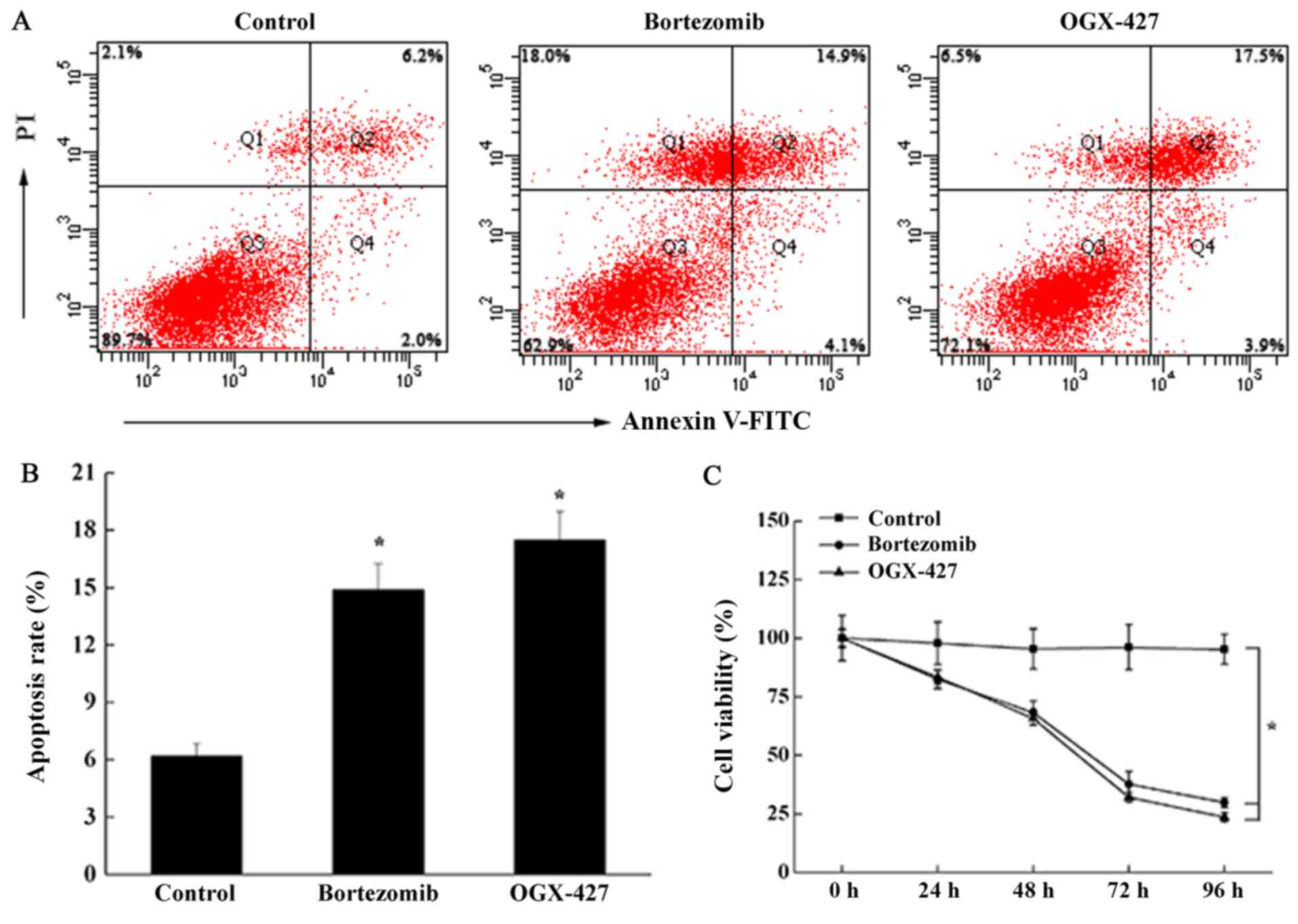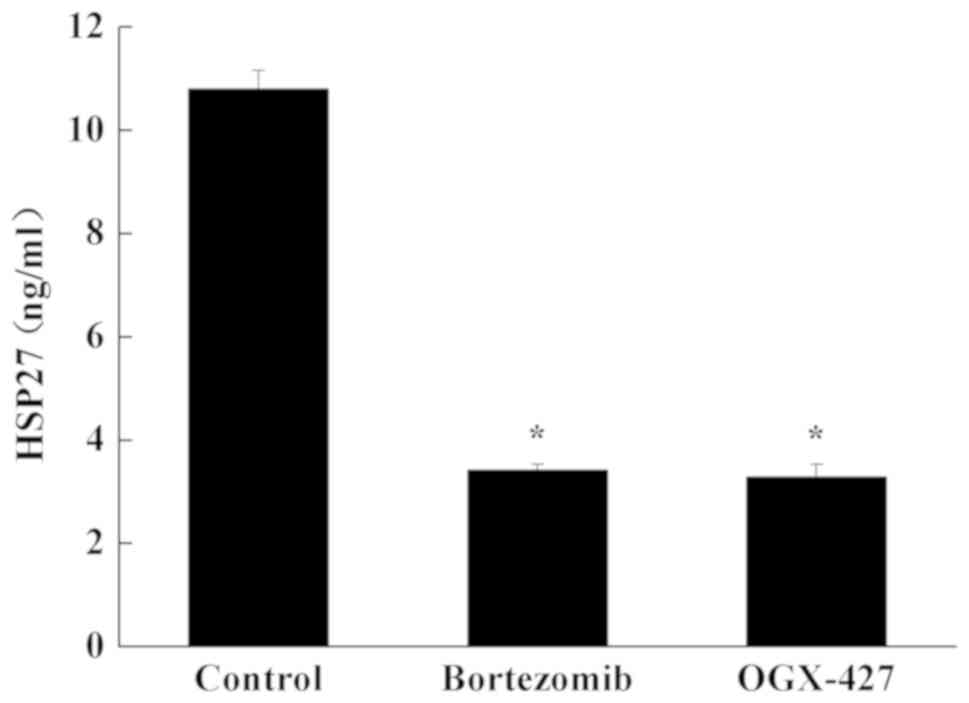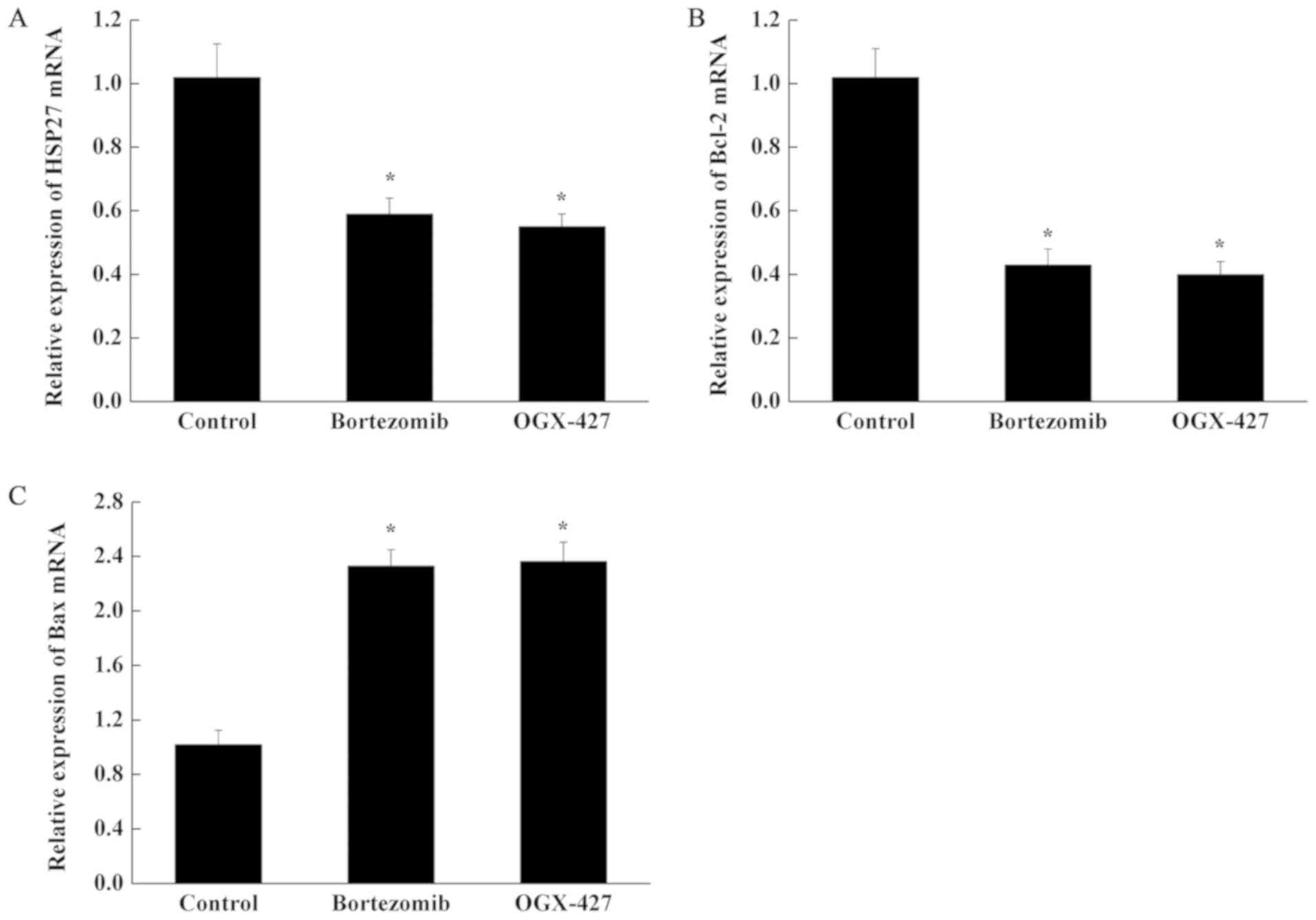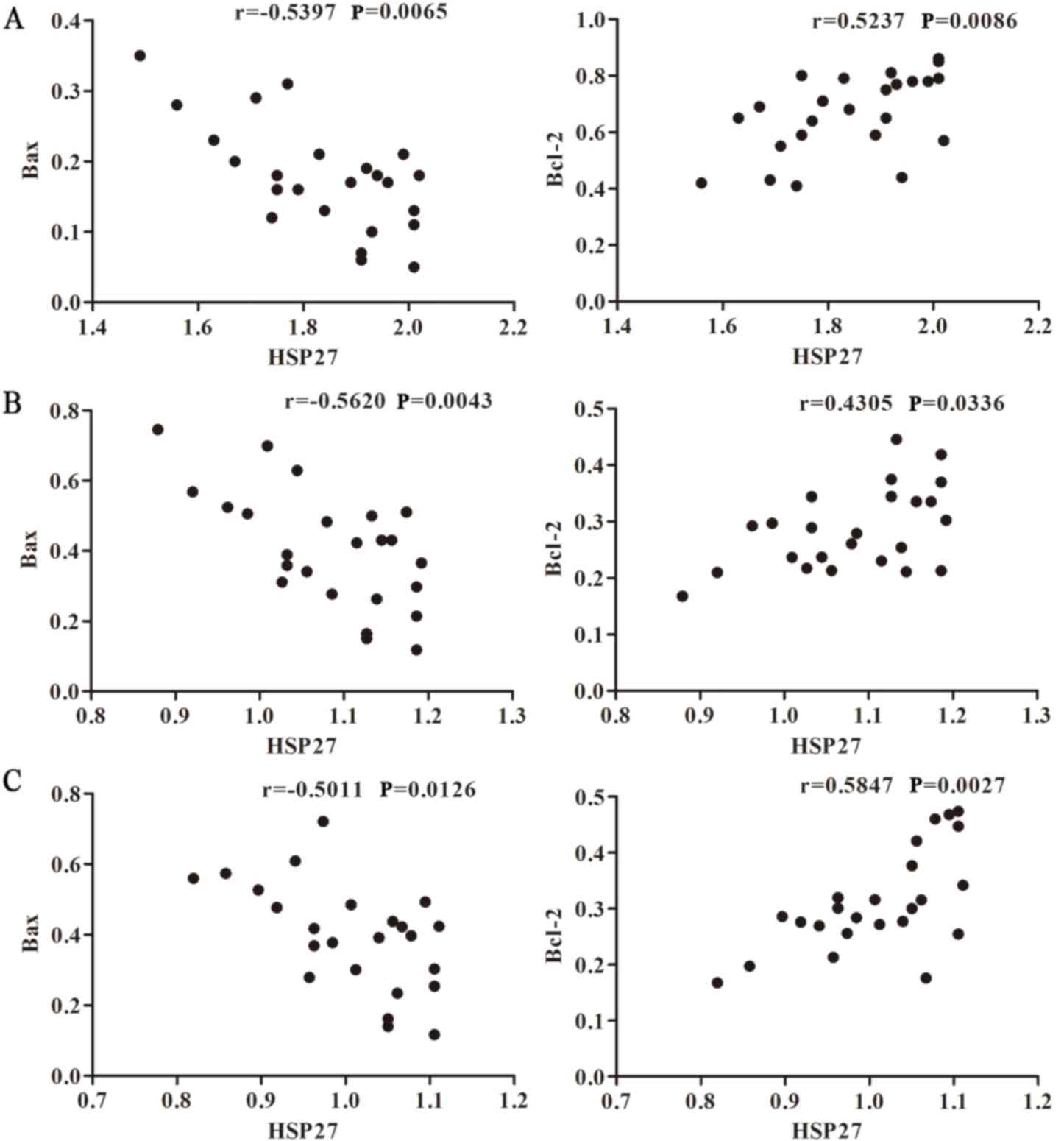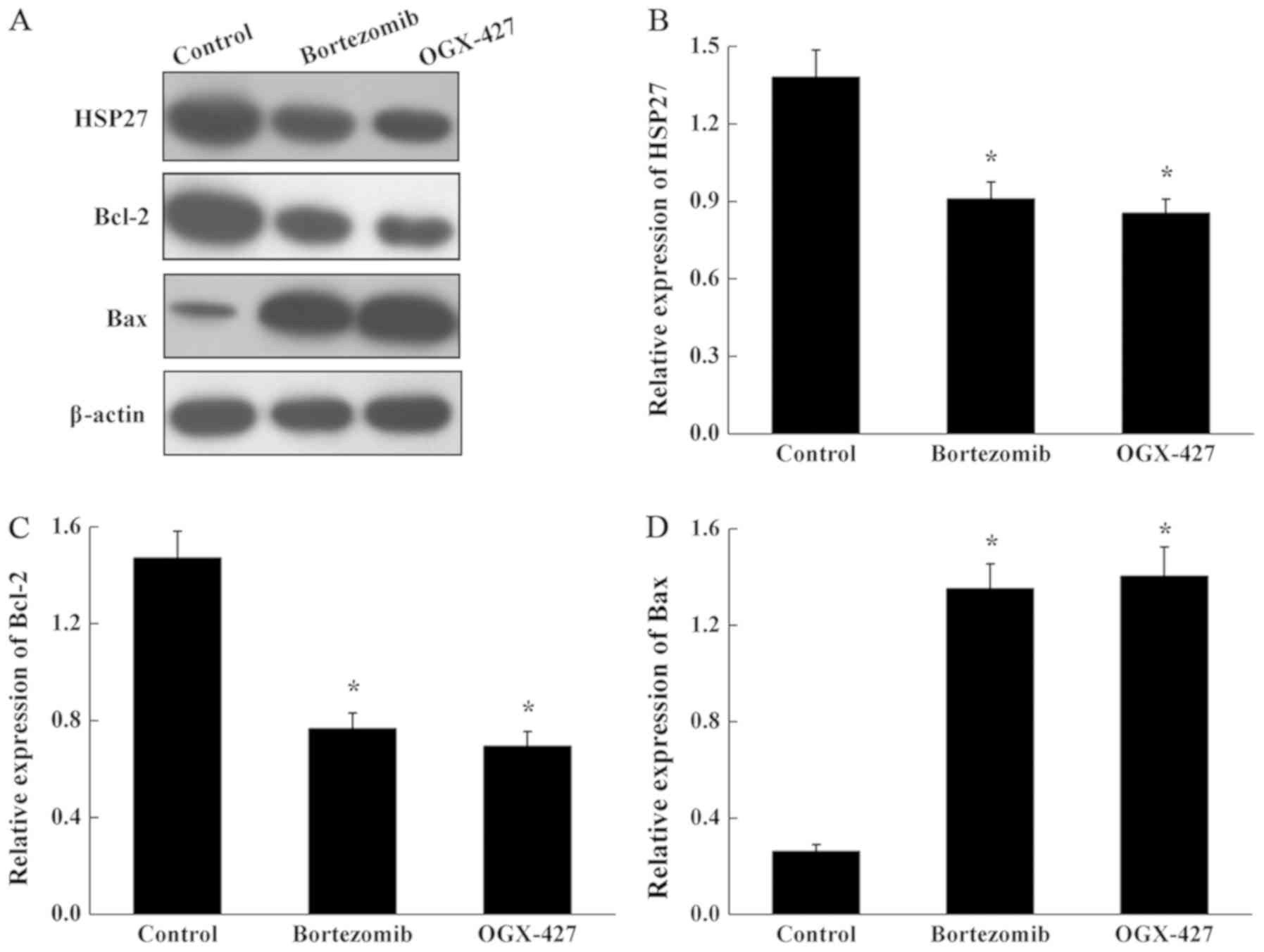Bortezomib promotes apoptosis of multiple myeloma cells by regulating HSP27
- Authors:
- Published online on: July 3, 2019 https://doi.org/10.3892/mmr.2019.10467
- Pages: 2410-2418
Abstract
Introduction
Multiple myeloma (MM) is a type of cancer that results from the malignant proliferation of plasma cells in the bone marrow (1,2). MM is the second most common B-cell neoplasm of the blood system. The incidence rate in the Chinese Han population is 1/10 million, and the incidence rate in developed countries is 4/10 million (3). The number of new cases in the United States in 2015 was ~28,000, with the number of new cases increasing year by year. (4). Myeloma accounts for 13.4% of all hematologic malignancies, 19% of all mortality due to hematological malignancies and 2% of all tumor-associated mortalities (5). In the United States, there were ~10,000 mortalities caused by myeloma in 2010 (6,7). The overall prognosis of patients with myeloma is poor. The median survival of patients receiving conventional therapy is 3–4 years (8). Certain new drugs have also been combined with conventional therapies in the clinic, which may further improve the prognosis and survival rate. However, the current results suggest that almost all patients will eventually relapse and it remains incurable, with a median overall survival of 4 years (9,10). Thus, there is urgent need to develop novel strategies for the treatment of MM and to improve the current treatments.
Immunotherapy can be used to control or eliminate minimal residual disease, which can consolidate the efficacy of chemotherapy or stem cell transplantation in patients (10). Myeloma cells secrete monoclonal immunoglobulins with unique antigenic determinants, which may become a tumor-specific antigen (10). A previous study reported the extraction and immunization of patients with idiotype immunoglobulin in the patient's plasma for immunotherapy, but the results are not satisfactory (11). This is partly due to the fact that this idiotypic immunoglobulin is less immunogenic and the antigen in each patient is unique. Other patients cannot be vaccinated or mediated by the idiotype immunoglobulin vaccine. The cytotoxic T cells benefit from the antimyeloma effect (10). Therefore, there is an urgent need for a new tumor-associated antigen to target in myeloma immunotherapy. This target should be an antigen common to most myeloma cells and can induce a strong immune response in most patients.
Heat shock proteins (HSPs) are a class of tumor-specific antigens with these characteristics. These HSPs include HSP27, HSP70 and HSP90. HSPs are highly expressed in numerous inflammatory disorders and tumors (12,13). High expression of HSP also indicates poor patient prognosis and increased drug resistance (2). In addition, HSPs are essential for the survival of tumor cells. Downregulation or inhibition of HSP expression leads to significant apoptosis of myeloma cells. HSP90 inhibitors have been used in clinical trials (12,14). These properties of HSPs make it a suitable for investigation as new tumor-associated antigen candidate. HSPs have been reported to be highly expressed in MM, but exhibit low expression in normal tissues, and to have a crucial role in the survival of myeloma cells (2). Studies have shown that HSP90 complexes are activated in cancer cells, but are inactive in normal tissues (15–17). All these features make HSPs an excellent target for tumor therapy. Since HSP27, the small HSP that is an ATP-independent chaperone, is reported to be overexpressed in several caner types including MM (18–22), it can be investigated as a potential therapeutic target for the treatment of MM.
Bortezomib, a first-in-class proteasome inhibitor, is used in for treatment of MM (23). Currently, bortezomib is approved for the treatment of myeloma in relapsed patients post-transplant or as a second line treatment in patients unsuitable for transplantation. In the present study, HSP27 expression was analyzed and compared in samples of 50 patients with MM following treatment with bortezomib combination with vincristine, doxorubicin and dexamethasone (VAD) traditional chemotherapy, or VAD chemotherapy alone. Further, we also performed the treatment in the myeloma cell line to determine the regulation of bortezomib on HSP27 expression. In addition, we also explore the correlation of HSP27 with apoptosis related genes.
Materials and methods
Case collection and grouping
Between February 2016 and February 2017, samples were obtained from 50 healthy subjects and 50 patients with MM at Rizhao People's Hospital (Rizhao, China). The ratio of men and women (M/F) was 23/27, and the average age was 58.85±3.06 years in patients with MM. For the healthy subjects the ratio of men and women was 30/20 and the average age was 57.58±7.41 years. After medical diagnosis and graded examination, 17 patients with MM (M/F, 7/10) were in the stage I MM group, 15 patients were stage II (M/F, 8/7) and 18 patients were stage III (M/F, 8/10). All diagnoses and classifications were based on the International Myeloma Working Group (IMWG) diagnostic criteria for MM (2014) (24) and the Revised International Staging System (ISS) international prognostic staging criteria (25). The nature and purpose of the study was explained to each subject and informed consent was signed. The study was approved by the Ethics Committee of Rizhao People's Hospital. Inclusion criteria for patients set for the study were as follows: i) Compliance with relevant diagnostic criteria set by the IWMG, confirmed by bone marrow analysis, X-ray film, blood image analysis and laboratory examination; ii) accordance with ISS standards and Durier-Salmon staging system staging criteria (26); iii) patients were newly diagnosed; iv) patients had received >3 courses of regular chemotherapy; and v) patients exhibited an expected survival of >3 months. Exclusion criteria were as follows: i) Patients were diagnosed with severe heart, liver, kidney, lung or blood system diseases; ii) patients exhibited secondary plasma cell enlargement; iii) patient presented increased primary disease and organ failure; iv) there were missing data or patients missed follow-ups.
The 50 MM cases were randomly divided into two groups (n=25/group), control group and observation group (clinical trial no. ChiCTR1900023172). VAD chemotherapy was performed in control group (NC group) by intravenous infusion of vincristine 0.5 mg/day for 1–4 days, intravenous infusion of doxorubicin 10 mg/day for 1–4 days, and oral administration of dexamethasone 40 mg/day for 1–4 days. Bortezomib in combination with VAD chemotherapy was administered to the observation group. On the basis of VAD chemotherapy, intravenous bortezomib 1.3 mg/m2 was administered on days 1, 4, 8 and 11. A period of treatment was defined as 28 days; a total of three periods of treatment were performed.
Determination of HSP27 expression in MM patients by ELISA
All samples were collected on patients with an empty stomach. Bone marrow (5 ml) was collected on the day prior to treatment and the first day following treatment, then sodium citrate was added to samples to prevent coagulation. Ficoll gradient centrifugation was performed to obtain the myeloma cells. The cells were centrifuged at 10,000 × g for 5 min at 4°C, then HSP27 was detected via ELISA according to the manufacturer's protocols (cat. no. 69-40173; MSK Bio). The optical density (OD) value was measured at 450 nm using a microplate reader (RT-6100; Rayto Life and Analytical Sciences Co., Ltd.).
Curative effect judgment
International unified curative effect standard was used for curative effect judgment. i) Complete remission (CR): Results of urine and blood immunofixation electrophoresis were negative, no plasmacytoma was present, and the proportion of plasma cells in bone marrow was <5%. ii) Very good partial response (VGPR): Urine, blood electrophoresis results were negative, but immunofixation electrophoresis results were positive, serum M protein levels decreased >90% and urinary M protein levels <0.1 g/24 h. iii) Partial remission (PR): A decrease in serum M protein content >50% and a urinary M protein level <0.2 g/24 h. iv) Stable condition (SD): Those who did not meet CR, VGPR and PR criteria. v) Progression of disease (PD): The increase in serum or urinary M protein levels was >25%, or the number of bone marrow plasma cells increased significantly. For those that met the criteria for PR or above, treatment was considered to be effective and the remission rate (%) was calculated as (CR+VGPR+PR)/total number of cases ×100.
Cell culture and grouping
Human multiple myeloma U266 cells were purchased from the American Type Culture Collection. Under aseptic conditions, U266 cells were cultured in RPMI-1640 medium containing 15% FBS (both Beijing Solarbio Science & Technology Co., Ltd.) in a 37°C and 5% CO2 incubator. The cells in the logarithmic growth phase were used for experiments. The cells were collected for analysis when at 80% confluency. The cells were divided into three groups: Control group without treatment, bortezomib group (10 nM bortezomib treatment) and HSP27 inhibitor group (200 nmol/l OGX-427 treatment). OGX-427 was obtained from OncoGenex Pharmaceuticals. OGX-427 is an anti-sense inhibitor targeting the HSP27 translation initiation site (5′-GGGGACGCGCGCTCGGTCAT-3′).
CCK-8 assay for cell proliferation
Logarithmic growth phase U266 cells were harvested and seeded in 96-well plates at a density of 5×104 cells/ml (100 µl per well). Cells treated as aforementioned were cultured at 37°C in a 5% CO2 incubator for 0, 24, 48, 72 and 96 h. CCK-8 solution (10 µl; Engreen) was added to each well, mixed and culture was continued for 4 h. The microplate reader was shaken and zeroed using a blank control well. The absorbance of each well was measured at 450 nm. The proliferation of the cells was calculated according using formula: Cell proliferation inhibition rate (%)=(1-OD experimental group/OD control group) ×100.
Detection of apoptosis by Annexin V-FITC/propidium iodide (PI) double staining
Cells treated as aforementioned were cultured for 24 h and then harvested. Cells (5×105/ml) were then stained using the Annexin V-FITC/PI Apoptosis Detection kit (eBioscience; Thermo Fisher Scientific, Inc.) according to the manufacturer's instructions. The stained cells were analyzed using a flow cytometer (Beckman Coulter, Inc.) and then the results assessed using CellQuest software version 6.0 (BD Biosciences).
Determination of HSP27 in myeloma cells by ELISA
The contents of HSP27 in myeloma cells were detected in accordance with the ELISA kit instructions (cat. no. ELH-HSP27-1; RayBiotech, Inc.), and the OD value was measured at 450 nm using a microplate reader (RT-6100; Rayto Life and Analytical Sciences Co., Ltd.).
Detection of HSP27, Bax and Bcl-2 mRNA expression levels by reverse transcription-quantitative PCR (RT-qPCR)
Total RNA was extracted using the TRIzol kit (Invitrogen; Thermo Fisher Scientific, Inc.; OD260/OD280 indicated between 1.8 and 2.0 for RNA purity). RT of cDNA was performed using SuperScript III Reverse Transcriptase (Thermo Fisher Scientific, Inc.); the reaction was performed at 37°C for 1 h. qPCR was performed using an SYBR Green kit (Invitrogen; Thermo Fisher Scientific, Inc.) in a Master EP realplex2 (Eppendorf). The reaction conditions were as follows: 95°C for 5 min, then 95°C for 15 sec and 60°C for 15 sec (40 cycles). Data were processed using the 2−ΔΔCq method (27) and relative expression levels were calculated using β-actin mRNA as an internal reference. The primer sequences were as follows: HSP27, forward 5′-GACGTCCAGAGCAGAGTCAGCCAG-3′, reverse 5′-GGTGGTTGCTTGAACTTTATTTGAG-3′; Bax, forward 5′-GACACCTGAGCTGACCTTGG-3′, reverse 5′-GAGGAAGTCCAGTGTCCACC-3′; Bcl-2, forward 5′-ATCGCTCTGTGGATGACTGAGTAC-3′, reverse 5′-AGAGACAGCCAGGAGAATCAAAC-3′; and β-actin, forward 5′-GTCCACCTTCCAGCAGATGTG-3′ and reverse 5′-GCATTTGCGGTGGACGAT-3′.
Western blot analysis of HSP27, Bax and Bcl-2 protein expression
Cells were lysed and centrifuged at 14,000 × g for 20 min, the the supernatant was removed and cell pellets were collected. The protein concentration was measured by using a BCA kit (Beijing Solarbio Science & Technology Co., Ltd.). Protein samples (4 µl) were added to 5X SDS loading buffer, and then separated by SDS-PAGE on 10% gels. Electrophoresis was performed at 80 V, and semi-dry electrotransfer to PVDF membranes (Merck KGaA) was performed at 20 V for 30 min. The membrane was washed and blocked with 5% nonfat milk for 2 h at room temperature. Rabbit anti-human HPS27 (1:1,000; cat. no. ab5579; Abcam), rabbit anti-human Bcl-2 (1:200; cat. no. ab32124; Abcam), rabbit anti-human Bax (1:200; cat. no. ab32503; Abcam) and rabbit anti-β-actin (1:1,000; cat. no. ABIN2854709; antibodies-online GmbH) antibodies were added and incubated overnight at 4°C. After washing, membranes were incubated with goat anti-rabbit IgG- horseradish peroxidase (1:1,000; cat. no. 7074; Cell Signaling Technology, Inc., USA) for 30 min at 37°C. The results were observed and recorded using a Roche Elecsys-2010 chemiluminometer (Roche Diagnostics). Protein expression levels were normalized to β-actin and quantified using ImageJ software version 1.46 (National Institutes of Health).
Statistical analysis
SPSS 19.0 statistical software was used to analyze the data. The data are expressed as the mean ± SD. Multiple comparisons were evaluated by one-way ANOVA with the least significant difference test used for follow-up analysis. Spearman's test was used for correlation analysis. Fisher's exact test was used to analyze the difference of total efficacy in age and gender groups, separately. The χ2 test was used to analysis the differences in clinical efficacy between the NC group and observation group. P<0.05 was considered to indicate a statistically significant difference.
Results
Expression of HSP27 in patients with MM at different stages
The HSP27 level was determined using ELISA (Fig. 1). Compared with the normal (healthy patients) group, the expression level of HSP27 in was significantly increased in patients with MM (P<0.05). The expression of HSP27 in patients with stage III MM was significantly higher than that in patients with stage II MM (P<0.05). The expression of HSP27 in patients with stage III and stage II MM was also significantly higher than that patients with stage I (P<0.05). The results indicated that the expression of HSP27 increased with the development of the disease.
Association between HSP27 and the curative effect after different treatments
As shown in Table I, 25 patients with MM ≤60 years old in the bortezomib-treated group had a mean age of 45.75±9.57, with eight male patients (75.0%), and six female patients (25.0%). Patients with MM >60 years old had an average age of 69.8±3.97, with five males (26.7%) and six females (73.3%). These results demonstrated that there was no significant difference in the treatment effect in the different age and gender groups (P>0.05).
As shown in Table II, the effective rate of the NC group was 56% and the effective rate of the observation group was 84%. The expression of HSP27 in patients with MM was decreased after routine treatment (NC) and bortezomib treatment (Fig. 2). The decrease the in bortezomib treatment group was significantly greater than that in routine treatment (NC) group. Compared with the PD group, the expression of HSP27 in the patients with total effective treatment was significantly decreased (P<0.05). These results suggest that bortezomib treatment significantly inhibited the expression of HSP27 in patients with MM.
Effect of bortezomib treatment on the growth and apoptosis of U266 cells
The results of the CCK-8 assay showed that bortezomib treatment inhibited the growth of U266 cells, and that the effect was increase over time (Fig. 3C). Compared with the control group, after U266 cells were treated with bortezomib or OGX-427 treatment for 48 h, U266 cell proliferation rate was significantly reduced (P<0.05). Cell proliferation rate in OGX-427 group was not significantly different to the bortezomib treatment group (P>0.05). Apoptosis of the cells was detected using the Annexin V/PI double staining method (Fig. 3A and B). Compared with the control group, the apoptosis of the cells was significantly increased by bortezomib treatment or OGX-427 treatment (P<0.05) but there was no significant difference in apoptosis between the bortezomib and OGX-427 treatment groups. These data demonstrated that bortezomib treatment could inhibit the proliferation of U266 cells and promote apoptosis.
HSP27 expression in myeloma cells
ELISA was performed to determine the HSP27 protein level in U266 cells. Compared with control group, the content of HSP27 in U266 cells was significantly decreased in the bortezomib group and OGX-427 group (P<0.05; Fig. 4). Compared with the bortezomib treatment group, the content of HSP27 in the OGX-427 group was unchanged (P>0.05; Fig. 4).
Expression of HSP27, Bcl-2 and Bax mRNA in U266 cells
Compared with control group, the expression of HSP27 mRNA and Bcl-2 mRNA in U266 cells was decreased significantly in the bortezomib and OGX-427 treatment groups, while the expression of Bax mRNA was increased significantly (P<0.05; Fig. 5). Compared with the Bortezomib group, the mRNA levels of three genes in the OGX-427 group were unchanged (P>0.05; Fig. 5).
Effect of bortezomib on the expression of HSP27 mRNA and Bcl-2, Bax mRNA in U266 cells
As shown in Fig. 6A, Spearman's analysis was used to verify the correlation between HSP27 and Bax and Bcl-2 prior to bortezomib treatment. The results revealed that HSP27 was negatively correlated with Bax expression (r=−0.5397; P=0.0065), but positively correlated with Bcl-2 expression (r=0.5237; P=0.0086). Following bortezomib treatment (Fig. 6B), the mRNA expression levels of HSP27, Bax and Bcl-2 in U266 cells were monitored. Spearman's analysis revealed a negative correlation between HSP27 and Bax, with a correlation coefficient of r=−0.562 (P=0.0043). There was a positive correlation between HSP27 mRNA and Bcl-2 mRNA, with a correlation coefficient of r=0.4305 (P=0.0336). Additionally, the correlations between HSP27, and Bax and Bcl-2 expression after adding OGX-427 inhibitor were analyzed. The correlation coefficients were −0.5011 (P=0.0126) and 0.5847 (P=0.0027), respectively (Fig. 6C). These results indicated that the expression of HSP27 is associated with apoptosis-related genes, Bcl-2 and Bax.
Effect of bortezomib on the expression of HSP27, Bcl-2 and Bax protein in U266 cells
As shown in Fig. 7, compared with the control group, the expression levels of HSP27 and Bcl-2 protein were significantly decreased in the bortezomib and OGX-427 treatment groups, and the expression of Bax protein was significantly increased in the in bortezomib and OGX-427 treated cells (P<0.05). The expression level of three proteins was not significantly altered in the in OGX-427 group compared with the bortezomib group (P>0.05).
Discussion
MM is a cancer of plasma cells, which are a type of white blood cell (28). The cause of MM is still unknown and the risk factors include alcohol, obesity, radiation exposure, family history and certain chemicals. The mechanism of MM involves the production of abnormal antibodies by plasma cells, which causes kidney problems and overly thick blood (8). MM is typically diagnosed based on bloods analysis, urine tests, bone marrow biopsy and medical imaging. MM is considered to be treatable, but not incurable, despite the rapid development of treatment strategies. Thus, novel therapeutic treatments re urgently needed for patients with MM.
HSPs are a family of molecular chaperones that have ac crucial role in protein folding and cellular protein homeostasis. In addition to these function, HSPs also have important role in the cancer development and often high expressed in a series of cancers (2). In the recent years, HSPs have been explored as a therapy target in cancer treatment, including MM. HSP90 inhibitors have been used in clinical trial for the treatment of MM (11–13,29). HSP70 inhibitors were also reported to induce MM tumor cell death (30). HSP27, a small HSP that is an ATP-independent chaperone protein, is reportedly overexpressed in several cancer types, including colorectal, breast and ovarian cancer, and and MM. HSP27 has an important role in inhibiting the release of the pro-apoptotic mitochondrial protein Smac in MM (19–22). Thus, HSPs can be explored as a therapeutic and treatment target in cancers that have high expression of HSPs. Bortezomib is an antitumor drug used as a first therapeutic proteasome inhibitor in certain human cancer types, including MM. The current study analyzed the effect of bortezomib on HSP27 expression when used in combination with traditional chemotherapy to investigate the role of HSP27 in MM, and thus determine the mechanism of how this combination treatment may benefit patients with MM.
Bortezomib is a synthetic reversible proteasome inhibitor that can inhibit tumors in multiple manners (31). It has been reported that bortezomib promotes BAX protein expression, thereby promoting tumor cell apoptosis (32). HSP27 exerts regulatory effects on apoptosis, proliferation and migration, including in tumor cells (33). It has been reported that HSP27 is overexpressed in various malignant tumors, such as breast cancer and leukemia (34,35). Therefore, the expression levels of HSP27 may be a useful indicator for the clinical evaluation of MM. The present results demonstrated that HSP27 was highly expressed in patient serum samples, and that expression levels increased as the cancer progressed. Following treatment with bortezomib combination with traditional chemotherapy or conventional treatment, HSP27 expression was significantly decreased at the mRNA and protein level. Notably, the combination treatment significantly increased the effective rate and the HSP27 expression was decreased in the bortezomib treatment group compared with the conventional treatment group. It has been previously reported that cell apoptosis is associated with the expression levels of HSPs (36). The data of the current study indicate that bortezomib treatment significantly promoted cell apoptosis and downregulated of the expression of HSP27. Further analysis demonstrated that HSP27 expression was positively correlated with the anti-apoptotic gene Bcl-2, and negatively correlated with the pro-apoptotic gene Bax. These results suggest the HSP27 has a role within the apoptotic pathways. Thus, in the future, patients may benefit from the combination treatment. HSP27 also can be explored as a potential therapeutic target.
In conclusion, bortezomib treatment downregulates HSP27 and alters the expression of apoptosis-regulating proteins Bcl-2 and Bax, and thus inhibits the proliferation and promotes the apoptosis of myeloma cells. All these results provide a potential method for the treatment of patients with MM.
Acknowledgements
Not applicable.
Funding
No funding was received.
Availability of data and materials
All data generated or analyzed during the present study are included in this published article.
Authors' contributions
JL and JQL participated in the design of the study. JL, XMZ, JYS, JG, XLW and JQL conducted the assays and performed the statistical analysis. JL, XMZ, JYS, JG, XLW and JQL drafted the manuscript. All authors read and approved the final manuscript.
Ethics approval and consent to participate
The study was approved by the Ethics Committee of Rizhao People's Hospital (clinical trial no. ChiCTR1900023172). All patients provided signed informed consent.
Patient consent for publication
Not applicable.
Competing interests
The authors declare that they have no competing interests.
References
|
Palumbo A and Anderson K: Multiple myeloma. N Engl J Med. 364:1046–1060. 2011. View Article : Google Scholar : PubMed/NCBI | |
|
Zhang L, Fok JH and Davies FE: Heat shock proteins in multiple myeloma. Oncotarget. 5:1132–1148. 2014. View Article : Google Scholar : PubMed/NCBI | |
|
Vos T, Allen C, Arora M, Barber RM, Bhutta ZA, Brown A, Carter A, Casey DC, Charlson FJ, Chen AZ, et al: Global, regional, and national incidence, prevalence, and years lived with disability for 310 diseases and injuries, 1990–2015: A systematic analysis for the Global Burden of Disease Study 2015. Lancet. 388:1545–1602. 2016. View Article : Google Scholar : PubMed/NCBI | |
|
Michels TC and Petersen KE: Multiple myeloma: Diagnosis and treatment. Am Fam Physician. 95:373–383. 2017.PubMed/NCBI | |
|
Mahindra A, Hideshima T and Anderson KC: Multiple myeloma: Biology of the disease. Blood Rev. 24 (Suppl 1):S5–S11. 2010. View Article : Google Scholar : PubMed/NCBI | |
|
Khan SA and Cohen AD: Experimental approaches in the treatment of multiple myeloma. Ther Adv Hematol. 2:213–230. 2011. View Article : Google Scholar : PubMed/NCBI | |
|
Costa LJ, Gonsalves WI and Kumar S: Early mortality in multiple myeloma: Risk factors and impact on population outcomes. Blood. 124:13202014.PubMed/NCBI | |
|
Peña C, Rojas C, Rojas H, Soto P, Cardemil D, Aranda S, Contreras C, La Roca G, Russo M, Pérez C, et al: Survival of 1,103 Chilean patients with multiple myeloma receiving different therapeutic protocols from 2000 to 2016. Rev Med Chil. 146:869–875. 2018.(In Spanish). View Article : Google Scholar : PubMed/NCBI | |
|
Landgren O: Shall we treat smoldering multiple myeloma in the near future? Hematology Am Soc Hematol Educ Program. 2017:194–204. 2017. View Article : Google Scholar : PubMed/NCBI | |
|
Briqle K and Roqers B: Pathobiology and diagnosis of multiple myeloma. Semin Oncol Nurs. 33:225–236. 2017. View Article : Google Scholar : PubMed/NCBI | |
|
Abdalla AO, Kokhaei P, Hansson L, Mellstedt H and Osterborg A: Idiotype vaccination in patients with myeloma reduced circulating myeloma cells (CMC). Ann Oncol. 19:1172–1179. 2008. View Article : Google Scholar : PubMed/NCBI | |
|
Khandia R, Munjal AK, Iqbal HMN and Dhama K: Heat shock proteins: Therapeutic perspectives in inflammatory disorders. Recent Pat Inflamm Allergy Drug Discov. 10:94–104. 2017. View Article : Google Scholar : PubMed/NCBI | |
|
Calderwood SK and Gong J: Heat shock proteins promote cancer: It's a protection racket. Trends Biochem Sci. 41:311–323. 2016. View Article : Google Scholar : PubMed/NCBI | |
|
Campanella C, Rappa F, Sciumè C, Marino Gammazza A, Barone R, Bucchieri F, David S, Curcurù G, Caruso Bavisotto C, Pitruzzella A, et al: Heat shock protein 60 levels in tissue and circulating exosomes in human large bowel cancer before and after ablative surgery. Cancer. 121:3230–3229. 2015. View Article : Google Scholar : PubMed/NCBI | |
|
Richardson PG, Chanan-Khan AA, Alsina M, Albitar M, Berman D, Messina M, Mitsiades CS and Anderson KC: Tanespimycin monotherapy in relapsed multiple myeloma: Results of a phase 1 dose-escalation study. Br J Haematol. 150:438–445. 2010.PubMed/NCBI | |
|
Richardson PG, Chanan-Khan AA, onial S, Krishnan AY, Carroll MP, Alsina M, Albitar M, Berman D, Messina M and Anderson KC: Tanespimycin and bortezomib combination treatment in patients with relapsed or relapsed and refractory multiple myeloma: Results of a phase 1/2 study. Br J Haematol. 153:729–740. 2011. View Article : Google Scholar : PubMed/NCBI | |
|
Stühmer T, Zöllinger A, Siegmund D, Chatterjee M, Grella E, Knop S, Kortüm M, Unzicker C, Jensen MR, Quadt C, et al: Signalling profile and antitumour activity of the novel Hsp90 inhibitor NVP-AUY922 in multiple myeloma. Leukemia. 22:1604–1612. 2008. View Article : Google Scholar : PubMed/NCBI | |
|
Yu Z, Zhi J, Peng X, Zhong X and Xu A: Clinical significance of HSP27 expression in colorectal cancer. Mol Med Rep. 3:953–958. 2010.PubMed/NCBI | |
|
Cornford PA, Dodson AR, Parsons KF, Desmond AD, Woolfenden A, Fordham M, Neoptolemos JP, Ke Y and Foster CS: Heat shock protein expression independently predicts clinical outcome in prostate cancer. Cancer Res. 60:7099–7105. 2000.PubMed/NCBI | |
|
Conroy SE, Sasieni PD, Amin V, Wang DY, Smith P, Fentiman IS and Latchman DS: Antibodies to heat-shock protein 27 are associated with improved survival in patients with breast cancer. Br J Cancer. 77:1875–1879. 1998. View Article : Google Scholar : PubMed/NCBI | |
|
Chauhan D, Li G, Hideshima T, Podar K, Mitsiades C, Mitsiades N, Catley L, Tai YT, Hayashi T, Shringarpure R, et al: Hsp27 inhibits release of mitochondrial protein Smac in multiple myeloma cells and confers dexamethasone resistance. Blood. 102:3379–3386. 2003. View Article : Google Scholar : PubMed/NCBI | |
|
Arts HJ, Hollema H, Lemstra W, Willemse PH, De Vries EG, Kampinga HH and Van der Zee AG: Heat-shock-protein-27 (hsp27) expression in ovarian carcinoma: Relation in response to chemotherapy and prognosis. Int J Cancer. 84:234–238. 1999. View Article : Google Scholar : PubMed/NCBI | |
|
Richardson PG, Hideshima T and Anderson KC: Bortezomib (PS-341): A novel, first-in-class proteasome inhibitor for the treatment of multiple myeloma and other cancers. Cancer Control. 10:361–369. 2003. View Article : Google Scholar : PubMed/NCBI | |
|
Rajkumar SV, Dimopoulos MA, Palumbo A, Blade J, Merlini G, Mateos MV, Kumar S, Hillengass J, Kastritis E, Richardson P, et al: International Mye-loma Working Group updated criteria for the diagnosis of multiple myeloma. Lancet Oncol. 15:e538–e548. 2014. View Article : Google Scholar : PubMed/NCBI | |
|
Greipp PR, San Miguel J, Durie BG, Crowley JJ, Barlogie B, Bladé J, Boccadoro M, Child JA, Avet-Loiseau H, Kyle RA, et al: International staging system for multiple myeloma. J Clin Oncol. 23:3412–3420. 2005. View Article : Google Scholar : PubMed/NCBI | |
|
Durie BG and Salmon SE: A clinical staging system for multiple myeloma correlation of measured myeloma cell mass with presenting clinical features, response to treatment and survival. Cancer. 36:842–854. 1975. View Article : Google Scholar : PubMed/NCBI | |
|
Livak KJ and Schmittgen TD: Analysis of relative gene expression data using real-time quantitative PCR and the 2(-Delta Delta C(T)) method. Methods. 25:402–408. 2001. View Article : Google Scholar : PubMed/NCBI | |
|
Raab MS, Podar K, Breitkreutz I, Richardson PG and Anderson KC: Multiple myeloma. Lancet. 374:324–339. 2009. View Article : Google Scholar : PubMed/NCBI | |
|
Nakashima T, Ishii T, Tagaya H, Seike T, Nakagawa H, Kanda Y, Akinaga S, Soga S and Shiotsu Y: New molecular and biological mechanism of antitumor activities of KW-2478, a novel nonansamycin heat shock protein 90 inhibitor, in multiple myeloma cells. Clin Cancer Res. 16:2792–2802. 2010. View Article : Google Scholar : PubMed/NCBI | |
|
Eugênio AIP, Fook-Alves VL, de Oliveira MB, Fernando RC, Zanatta DB, Strauss BE, Silva MRR, Porcionatto MA and Colleoni GWB: Proteasome and heat shock protein 70 (HSP70) inhibitors as therapeutic alternative in multiple myeloma. Oncotarget. 8:114698–114709. 2017. View Article : Google Scholar : PubMed/NCBI | |
|
Boccadoro M, Morgan G and Cavenagh J: Preclinical evaluation of the proteasome inhibitor bortezomib in cancer therapy. Cancer Cell Int. 5:182005. View Article : Google Scholar : PubMed/NCBI | |
|
Adams J: Proteasome inhibition in cancer: Development of PS-341. Semin Oncol. 28:613–619. 2001. View Article : Google Scholar : PubMed/NCBI | |
|
Ciocca DR and Vargas-Roig LM: Hsp27 as a prognostic and predictive factor in cancer. Prog Mol Subcell Bill. 28:205–218. 2002. View Article : Google Scholar | |
|
Wei L, Liu TT, Wang HH, Hong HM, Yu AL, Feng HP and Chang WW: Hsp27 participates in the maintenance of breast cancer stem cells through regulation of epithelial-mesenchymal transition and nuclear factor-κB. Breast Cancer Res. 13:R1012011. View Article : Google Scholar : PubMed/NCBI | |
|
Gonzalez-Mejia ME, Voss OH, Murnan EJ and Doseff AI: Apigenin-induced apoptosis of leukemia cells is mediated by a bimodal and differentially regulated residue-specific phosphorylation of heat-shock protein-27. Cell Death Dis. 1:e642010. View Article : Google Scholar : PubMed/NCBI | |
|
Lanneau D, Brunet M, Frisan E, Solary E, Fontenay M and Garrido C: Heat shock proteins: Essential proteins for apoptosis regulation. J Cell Mol Med. 12:743–761. 2008. View Article : Google Scholar : PubMed/NCBI |



